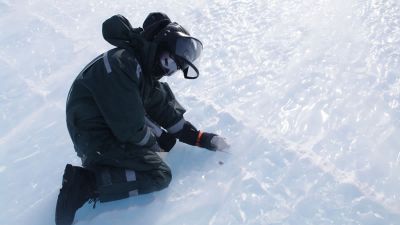
SAMBA: Collecting Meteorites in Antarctica
The SAMBA project is the Belgian contribution to the Search for Antarctic Meteorites. The program is an initiative of the Vrije Universiteit Brussel and the Université Libre de Bruxelles in collaboration with the Japanese Institute of Polar Research in Tokyo and is supported by the Belgian Science Policy (BELSPO) and the International Polar Foundation (IPF).
From mid-December to the end of January 2013, a Belgian-Japanese team will search for meteorites in the Nansen Ice field to the South of the Sør Rondane Mountains and the Princess Elisabeth Station.
Understanding how our planet works necessitates studying its interior. Direct geological records only document the crustal or uppermost fraction of our planet while the deeper parts remain totally outside of our reach. Meteorites coming from the asteroid belt between Mars and Jupiter have recorded information on how other planets formed and evolved through time; from undifferentiated primitive asteroids to differentiated small planets, showing the development of a crust, a mantle, and a metallic core just like those of the Earth. After these asteroids have been broken apart by collision with others bodies in space, small fragments of their metallic core and/or silicate mantle can potentially fall on Earth, where they are recovered and studied.
About 37000 tons of meteorites fall on Earth each year, mainly as dust, and only 0.0001% have a mass between 10 g and 1 kg. Very few meteorite falls are directly observed. About 2/3 of the meteorites are lost in seas and oceans, and at first sight, the remaining part does not look very different from the normal rocks in our backyards. Consequently, they weather away before being collected. However, extraterrestrial rocks falling in hot and cold dry places, like deserts or ice fields, are better preserved and easily found. In Antarctica, glacier movements concentrate the meteorites. Meteorites fall on the ice sheet and are incorporated into a pile of snow and ice. Glaciers move until mountains block the ice flow. Then, the ice is slowly eroded by powerful winds, liberating their bounty of imprisoned meteorites. At remarkable places, as for instance in the ice fields south of the Sør Rondane mountains, meteorites can be concentrate up to hundreds of specimens per square km. About half of the total number of meteorites recovered on Earth so far (~40 000) comes from Antarctica! Antarctic meteorites are additionally special because they are buried frozen, preventing them from being contaminated by their terrestrial environment.
Thanks to the SAMBA project, Belgium will acquire a large collection of meteorites that will benefit to the entire international scientific community. Once these extraterrestrial rocks are studied, the most beautiful meteorite fragments will be exhibited for the public.
Picture: Meteorite in Antarctica - © JARE 51 / IPF
